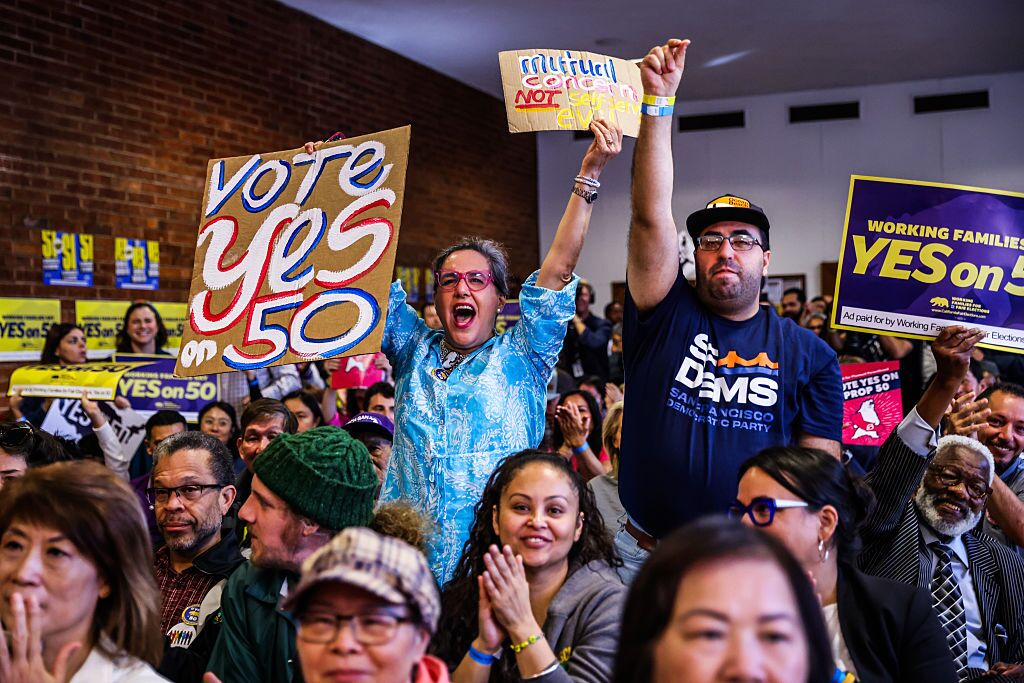Is Prop 50 the beginning of the end of America’s imperial presidency?
Results are still flooding in, but it’s official: California voters have rebuked Republican-led efforts to gerrymander future elections by passing Proposition 50, the Election Rigging Response Act, a temporary redistricting measure designed to create five additional Democratic seats in Congress. (Track live polling data from the California secretary of state here.)
The passage of Prop 50 represents:
- a turning point for voters and activists seeking to translate resistance movements—like No Kings; campus-based protests against attacks on higher education, academic freedom and federal funding; regular demonstrations in cities with large immigrant communities in response to raids and other new policies; and other daily and weekly protests—into electoral participation and structural reform.
- a victory for California’s state leadership, especially Gov. Gavin Newsom, the driving force behind Prop 50.
- a major boost for Americans who had grown weary of daily political assaults, especially those whose families have borne the brunt of policies that undermined workers and women, widening inequality.
Texas Republicans, including Gov. Greg Abbott, placed redistricting on his special-session agenda after Trump intervened with a phone call to the governor. In response, Newsom announced, “Two can play that game,” and quickly convinced the California Legislature to adopt new maps, creating five additional Democratic seats in Congress.
Unlike Texas, California’s new maps required approval by California voters.
In 2021, a bipartisan California Citizens Redistricting Commission had voted unanimously to approve maps for the congressional districts in which Democrats would hold 43 of the state’s 52 U.S. House seats, based on the 2020 U.S. Census.
Now—as summarized by the independent nonpartisan California Legislative Analyst’s Office—Prop 50 replaces those maps with new, legislatively drawn maps. While the new Prop 50 map must follow federal law, it is not required to follow the state requirements previously created by the Commission. Instead, the state will temporarily use the new map (in which the total number of districts has not changed) for all congressional elections in 2026, 2028 and 2030, until the Commission draws new district maps, following the 2030 U.S. Census.
The California League of Women Voters confirms Prop 50 will change the percentage of registered Republicans and Democrats in 10 districts, so that Democrats would have an advantage in five districts currently represented by Republicans.
Those five more Democrats in Congress could make a huge difference, since Republicans currently occupy 219 out of the 435 seats in the U.S. House—a razor-thin margin of only one vote.
As UCLA School of Law Professor Rick Hasen, a leading authority on election law, sees it: The passage of Prop 50 means a majority of California voters agreed with the argument that “the fairness of congressional districting should be judged on a national basis, and if Republicans are engaging in partisan gerrymandering in states they control, Democrats need to fight back.”

Voters rejected opponents’ arguments that “two wrongs don’t make a right” and that there was no compelling reason to override the commission’s nonpartisan maps.
Prop 50 also proposes an amendment to the U.S. Constitution requiring that redistricting be done by “fair, independent, and nonpartisan redistricting commissions nationwide,” confirming California’s support for a uniform national approach to redistricting.
Prop 50’s Potential Impact on the 2026 Midterms
The passage of Prop 50—combined with the elections of Zohran Mamdani as mayor of New York City, Rep. Mikie Sherrill as governor of New Jersey (the second-ever woman in the role, defeating Jack Ciattarelli, the Republican endorsed by Trump), and former U.S. Rep. Abigail Spanberger as governor of Virginia (the state’s first female governor), and the retention all three Democratic members of the Pennsylvania Supreme Court—led pundits to label the night a “sweep” for Democrats in a “major blue wave.”
If Democrats secure control of Congress next year, they will choose the House speaker, who appoints all committee chairs. Those chairs could issue subpoenas to members of the Trump administration and launch oversight investigations, which can be broadcast live for the press and the public.
Democrats could pass legislation reversing the budget bill enacted by Republicans and signed by Trump on July Fourth. They could also pursue measures to rebuild and expand social and economic protections, and begin the work of healing the country.
The National Partnership for Women & Families has identified 35 ways the Trump administration has harmed women and families in its first 100 days, describing “a barrage of harmful Executive Orders, confirmation hearings for dangerous and unqualified political nominees, unprecedented firing of federal employees along with restructuring or near elimination of many federal agencies.” Amidst a “nonstop, chaotic whirlwind of daily breaking news, court decisions and more, the Administration is abusing its power to turn back the clock on rights and protections for hundreds of millions of people,” particularly “women and their families.”
If Republicans then block these reforms in the Senate or if Trump vetoes them, Democrats will have a clear message for 2028: They are the party standing for freedom, fairness and opportunity for all.
Prop 50 Victory Emboldens Growing Resistance and Civic Engagement Movement
The accelerated 90-day campaign to pass Prop 50 both drew upon and bolstered the extraordinary grassroots resistance building since Trump was sworn in on Jan. 20.
“When Gov. Newsom announced that Prop 50 would go to a special election, Indivisible Sonoma County jumped into action,” Madeleine Waldmann, a leader of the group, told Ms. “Within hours, our Advisory Council endorsed it, and within days our volunteers were phone-banking, writing postcards, canvassing, and hanging freeway banners seen by more than 100,000 drivers each day. Prop 50 gave our members exactly what they’d been waiting for: a hopeful, concrete way to defend democracy and push back against MAGA extremism.”
Waldmann is an example of millions of people around the country raising their voices, rallying volunteers, getting out the vote and “reminding everyone that democracy is a full-time job.”
The victory on Prop 50 gives activists in California—and across the country—a chance to flex their electoral power ahead of the 2026 midterms. After months of organizing at Hands Off and No Kings Day rallies and leading boycotts of Tesla, Home Depot and Google, they’re now channeling that momentum into real wins at the ballot box.
Buoyed by this and other victories, grassroots movements are proving that the power of the people is resilient … and growing.
Great Job Stephen Rohde & the Team @ Ms. Magazine Source link for sharing this story.



